BEE APRIL 2021
Southward Bound & Around Mulegé
 Too much time has passed since we were last in Mexico and my last entry. Our three day trip in late January 2021 retraced our northward journey last Spring (see Aug 2020 and Sep 2020). We started in the Mexicali area and traveled southward along the Upper Rio Colorado Delta and the Gulf of California, then south west across the Peninsular Range to Laguna Chapala in the Central Desert, south to the Pacific Ocean at Guerrero Negro, and east again to the Gulf and Mulegé. Traffic was practically non-existent due to the decrease in tourism precipitated by the Covid-19 pandemic.
Too much time has passed since we were last in Mexico and my last entry. Our three day trip in late January 2021 retraced our northward journey last Spring (see Aug 2020 and Sep 2020). We started in the Mexicali area and traveled southward along the Upper Rio Colorado Delta and the Gulf of California, then south west across the Peninsular Range to Laguna Chapala in the Central Desert, south to the Pacific Ocean at Guerrero Negro, and east again to the Gulf and Mulegé. Traffic was practically non-existent due to the decrease in tourism precipitated by the Covid-19 pandemic.
Hwy 5 — North of San Felipe to Laguna Chapala
Two days before we left Los Algodones (east of Mexicali and just across the border from Yuma, AZ), a wet storm passed through. It rained for a day and a half between the international border at least as far south as Mulegé. Heading south, there were already signs of green across the desert flats and hills, probably from both new growth and the rain having rinsed off all the accumulated dirt from the shrubs and trees. There was even standing water all along the highway and in the saltflats.
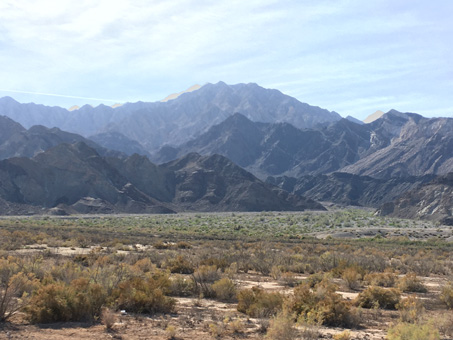
The Sierra Mayor at Km 58, just south of the small town of Cucupá located on the Rio Hardy.
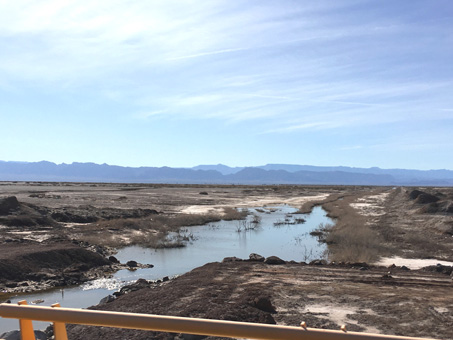
Laguna Salada. Km 75. Rainwater still standing in the saltflats.
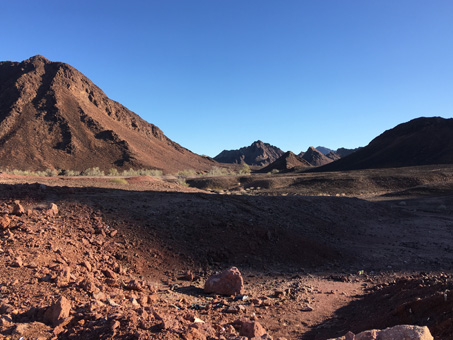
Km 96 S of Mexicali at the edge of the Sierra las Pintas. A Mars-scape. The vegetation was incredibly sparse and low on what looks to be a cinder field.
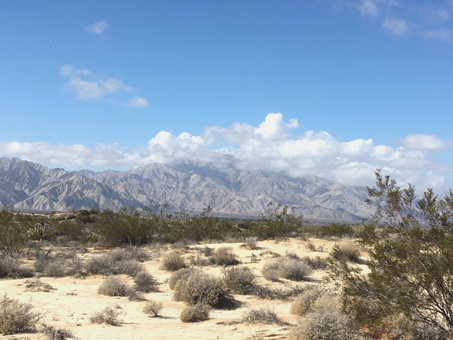
The Sierra San Pedro Mártir and Picacho del Diablo, west of San Felipe. The air was clear and calm after the rainstorm.
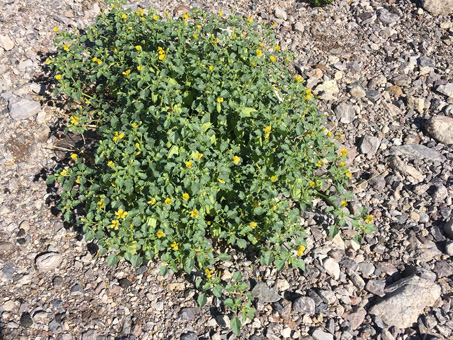
For a number of miles along the side of the highway north of Puertecitos, I kept seeing small rounded plants with bright yellow flowers.
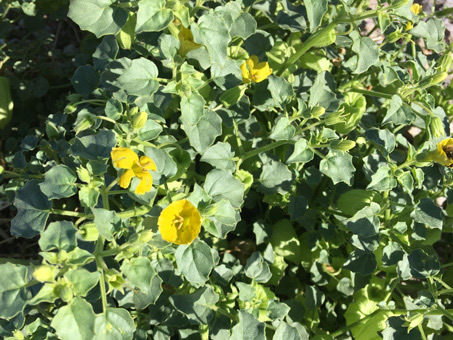
I was finally able to pull over safely near a group of plants. What I found was a new-to-me taxon of Ground Cherry, Physalis crassiflolia var. infundibularis (Solanaceae).
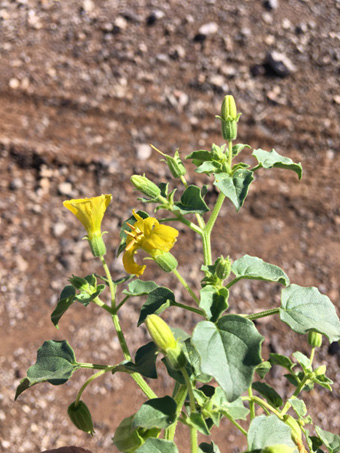
The flowers caught my eye. The corollas were mostly funnelform, unlike the rotate limb of var. crassifolia that I know best from around Mulegé.
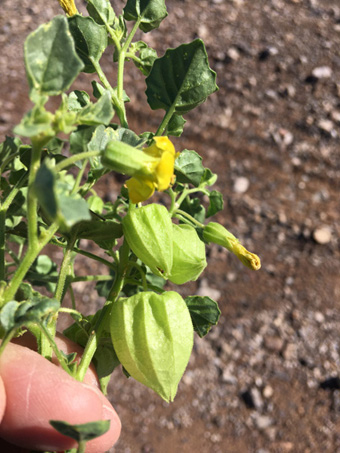
The sepals had the typical 10 ribs of the species, but seemed more elongated than var. crassifolia.
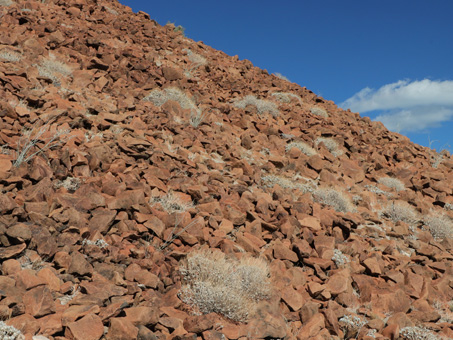
Km 111 S of Puertecitos. The hills along the Gulf are sparsely vegetated, here with dormant Brittlebush (Encelia farinosa var. phenocodonta, Asteraceae).
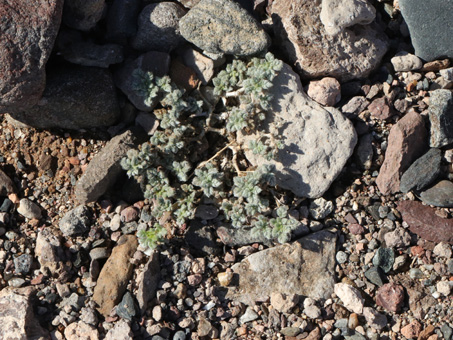
A very small Gulf Crinklemat (Tiquilia cuspidata, Ehretiaceae) gaining a foothold at the base of a rocky hillside. These perennials are tough: Their tiny, thick leaves are densely bristly hairy & they are very drought tolerant, often looking quite dead in dry times.
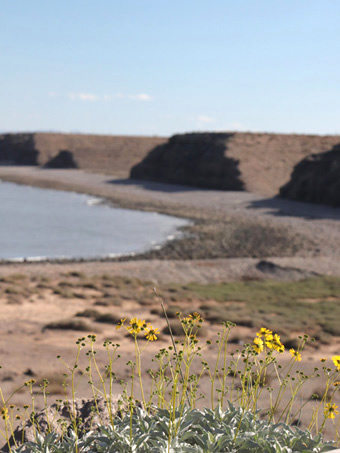
One of a few Brittlebush (Encelia farinosa var. phenicodonta, Asteraceae) seen blooming along the route.
Around Mulegé — the Valley
When we finally got out into the field in early February, I couldn't stop remarking how dry everything looked. In spite of the rain a few weeks before, there was little sign of the usual winter annuals. Everywhere I looked in the valley, the ground between shrubs and trees seemed completely bare, eaten to nubs or beyond by the free-ranging livestock. And you know it's dry when the Buffelgrass (Cenchrus ciliare, Poaceae) appears totally dead or the Mesquites are for the most part leafless. We seem to be going into a drought cycle as there has been hardly any rain since March 2020. This season, it looks like I´ll be honing my identification skills (and rounding out my photo collection) of dry, leafless or shriveled up examples of local species.
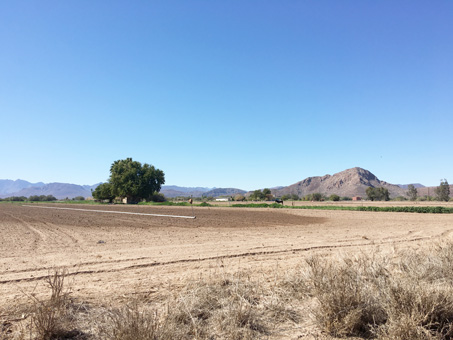
Field being prepared for planting. Notice the dry and crumbling Buffelgrass in the foreground.
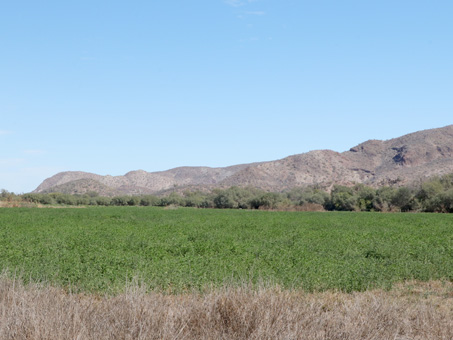
A field of alfalfa, made possible by the valley's aquifer.
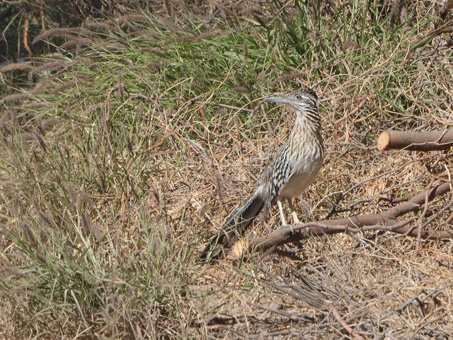
Roadrunner pausing between fields to watch me watching it.
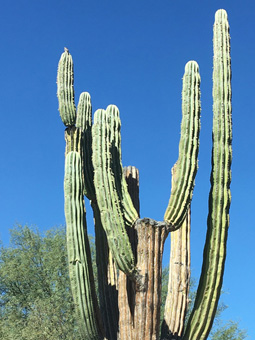
Large Cardón (Pachycereus pringlei, Cactaceae)
with a Kestrel perched above.
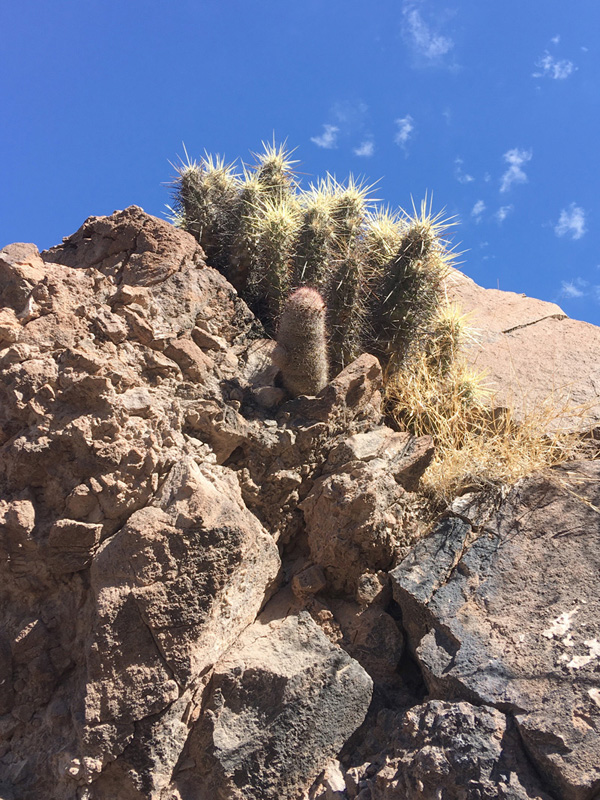
Hedgehog cactus (Echinocereus brandegeei, Cactaceae) and Fishhook cactus (Mammillaria dioica var. dioica, Cactaceae).
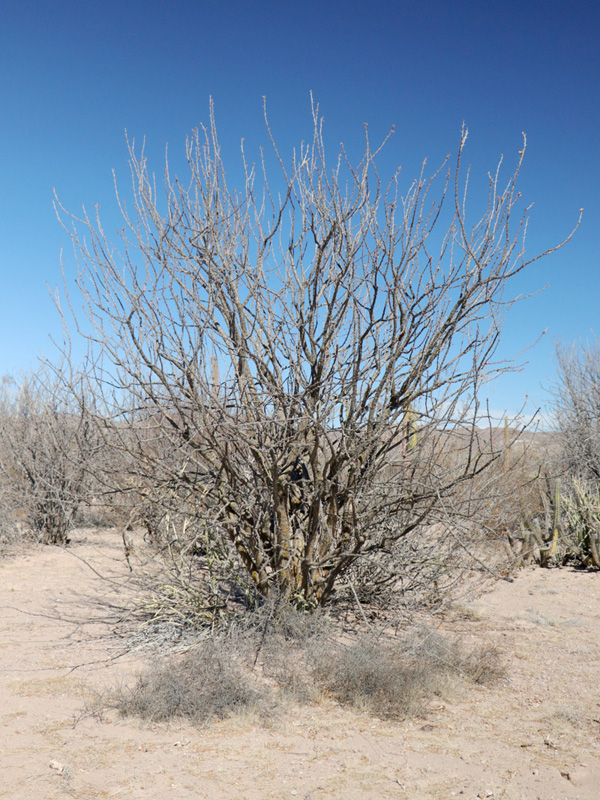
Palo Adán (Fouquieria diguetii, Fouquieriaceae) with Green Rhatany (Krameria paucifolia, Krameriaceae) in the foreground. So dry!
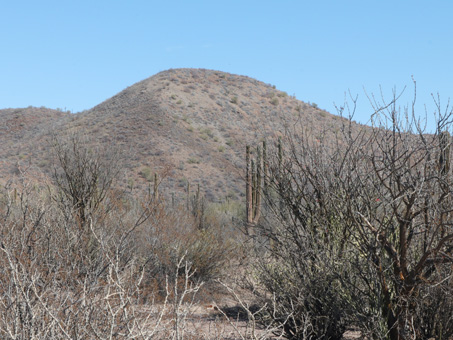
A northwest slope of the the Sierra Azteca. Most plants were leafless.
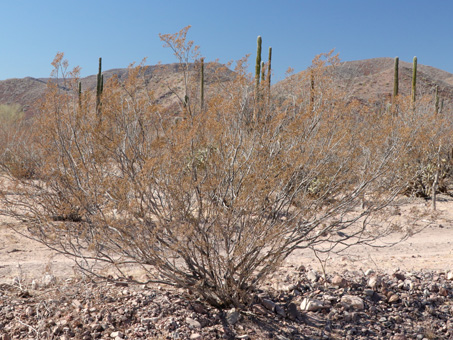
Again, you know it's dry when even the tough Creosotebush (Larrea tridentata, Zygophyllaceae) have only crispy, coppery-colored leaves.
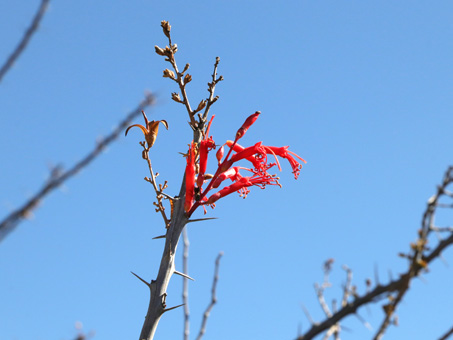
Every now and then, I'd see a few flowers on the Palo Adán (Fouquieria diguetii), evidence of the small amount of rain a few weeks before.
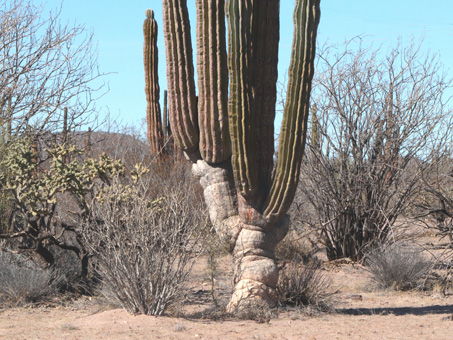
The trunk of this Cardón (Pachycereus pringlei) looked like it might have melted in the desert heat.
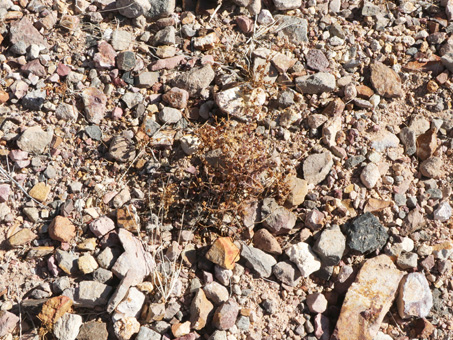
The annual or biennial sandmats like this one (Euphorbia polycarpa, Euphorbiaceae) were not doing well. The ID stumped me for a moment.
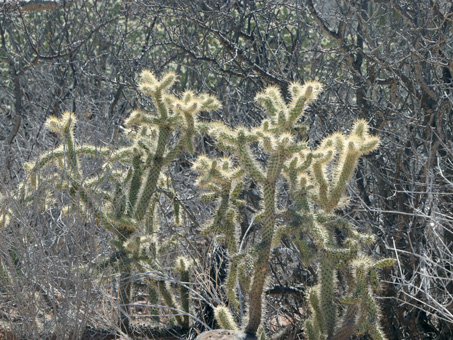
Sun shining through the spines of Cholla barbona (Cylindropuntia alcahes var. alcahes, Cactaceae), a peninsular endemic cactus. It really stood out because of the lack of leaves on the surrounding plants.
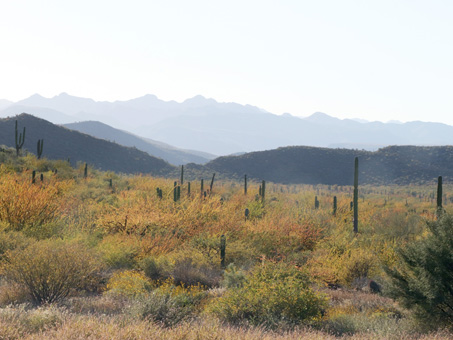
Last February (2020), we returned to Mulegé from a brief trip northward to find the vegetation displaying what in the US we would call "fall colors". The area had seen a substantial amount of late summer 2019 rain and the shrubs and trees were loaded with leaves until about early January when they slowly started to dry out.
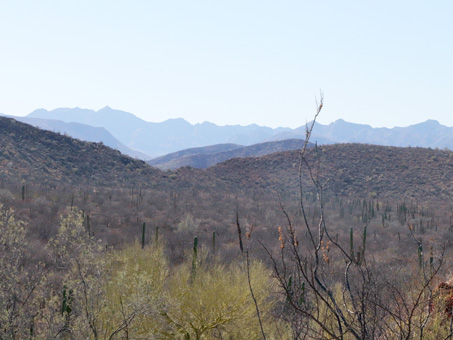
The same area at left in February 2021. The summer was so dry that plants that are commonly quite leafy in the winter were bare. This included Mesquite (Prosopis articulata and P. palmeri, Fabaceae), Creosotebush, Palo Verde (Parkinsonia microphylla, Fabaceae), and our two Elephant tree species (Bursera hindsiana and B. microphylla, Burseraceae).
Around Mulegé — el Equipalito (ancient marine terrace and dunes)
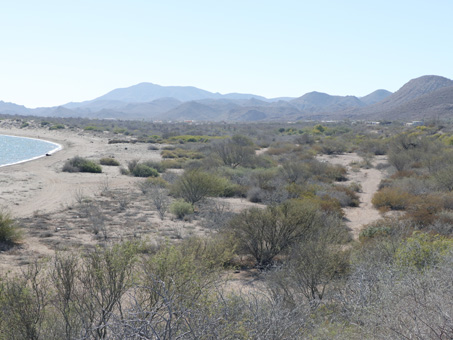
Dry, dry, dry. Lots of gray here on the old sea terrace and dunes around El Equipalito. Panorama continues at left, moving inland and up onto the terrace.

Here, the green was principally Sweet Mangrove (Maytenus phyllanthoides, Celastraceae), a species that is mostly found inland, prefering dunes, salt flats and their transition zones.
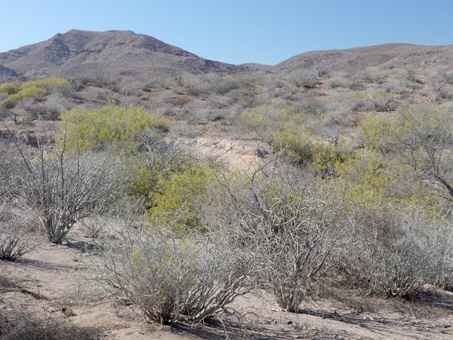
The old marine terrace has accumulated dunes along its lower flanks. The vegetation is basically the same as the surrounding desert scrub. Sweet mangroves stand out as bright green spots on the slopes.
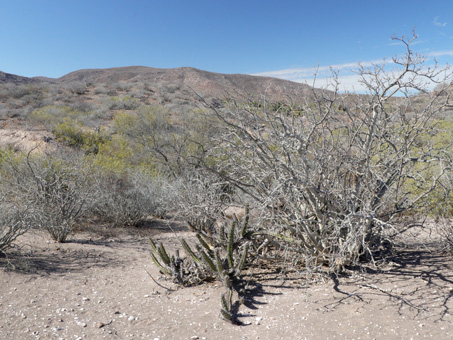
There are a few species here that are more common locally in dunes, such as Gulf Crinklemat (Tiquilia cuspidata) and California Desert Thorn (Lycium californicum var. californicum, Solanaceae).

Most of the Limberbush (Jatropha cuneata, Euphorbiaceae) looked like this, with not a leaf in sight. The flexible branches and knobby side shoots make ID easy.
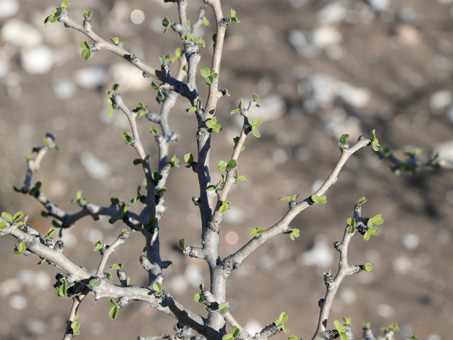
Occasionally, some of the Limberbush had a few leaves in response to the brief rain; the leaves here are about 5 mm L. The stem color varies: gray, golden, greenish, streaked, or even appearing blackened.
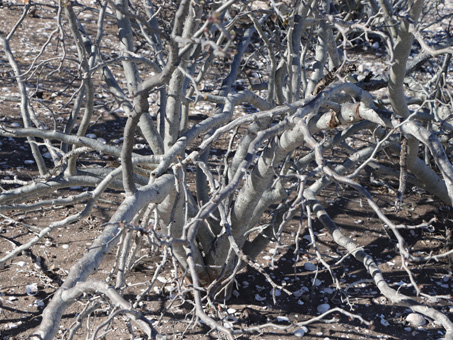
Most of the Ashy Limberbush (Jatropha cinerea, Euphorbiaceae) looked like this. The long, flexible, often wandlike branches, as well as the smooth gray bark distinguish this species. It too has knobby side shoots but they are widespread and fewer than J. cuneata.
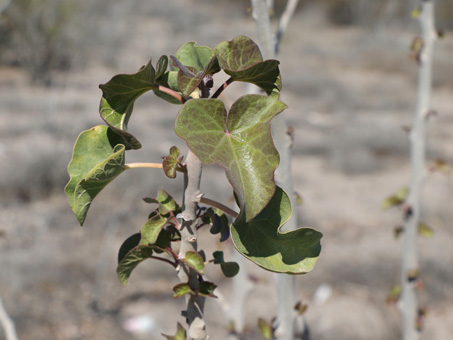
Very few of the Ashy Limberbush were sporting their distinctive heart-shaped leaves. These had recently started to sprout and were mostly about 2-3 cm L and can reach 5+ cm L.
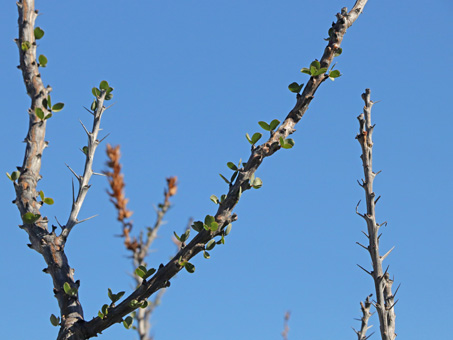
The White Tree Ocotillo/Palo Adán (Fouquieria burragei, Fouquieriaceae) had very few leaves. This species blooms mostly July to Oct-Nov. and doesn´t seem bloom in response to small amounts of rain like the red-flowered species (F. diguetii).
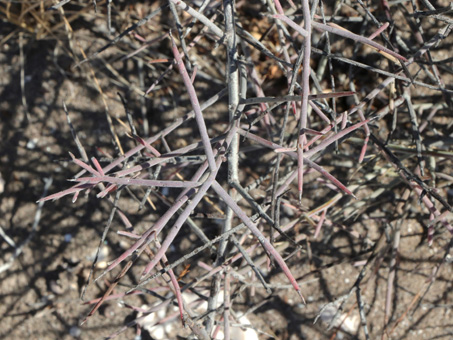
Bare branches of Green Rhatany (Krameria paucifolia). The branch color varies and can be greenish, gray-green, black, purple or red-tinged. Leaves, when present, are about 1 cm L x 2 mm W and sparse.
Around Mulegé — El Gallito Beach
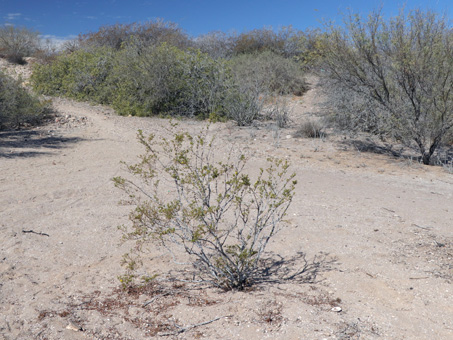
A small Creosotebush (Larrea tridentata) on a rear dune of Playa El Gallito. It was one of a few with green leaves.
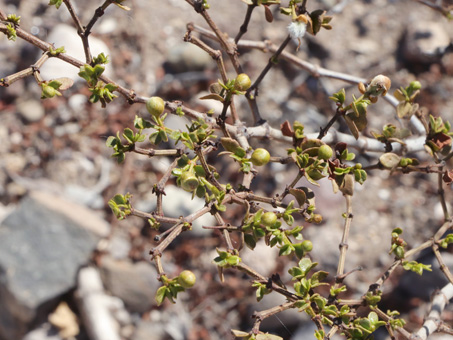
The Cresotebush had some buds and a few old fruit.
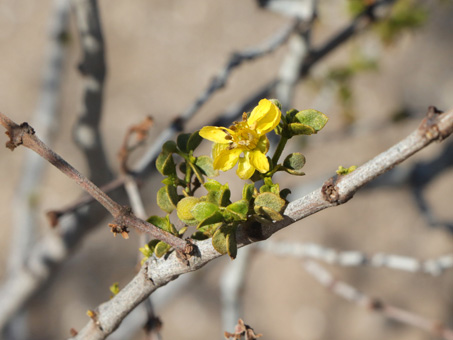
The Creosotebush also had a lone flower.
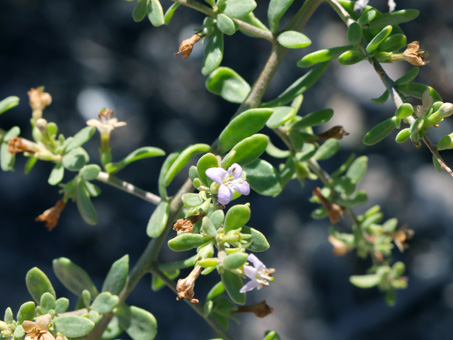
Along the rear dunes, the desert thorn (Lycium brevipes var. brevipes, Solanaceae) was the other species, along with Sweet Mangrove, that was actually green.
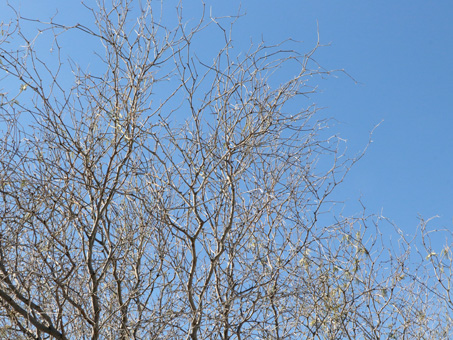
Mesquite (Prosopis articulata) on the rear dune with just a few leaves.

A pleasant surprise: a globemallow (Sphaeralcea axillaris var. violacea, Malvaceae) in bloom on the dune.
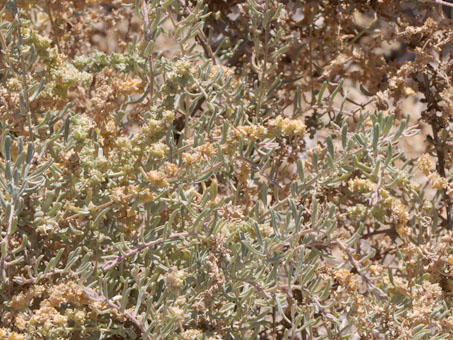
Slender-leaf Saltbush (Atriplex linearis, Chenopodiaceae).
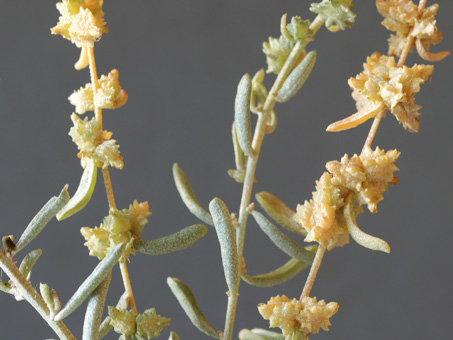
Pistillate bracts of Slender-leaf Saltbush. Each fleshy bract holds a seed.
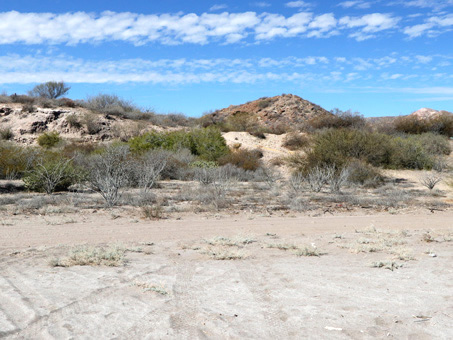
The rear dunes are very dry.
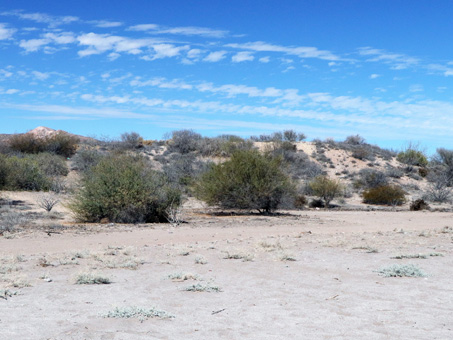
The number, height and coverage of the usual dune plants, mostly Dye Weed (Psorothamnus emoryi var. emoryi, Fabaceae) and Spanish Needle (Palafoxia linearis, Asteraceae), were much diminished.
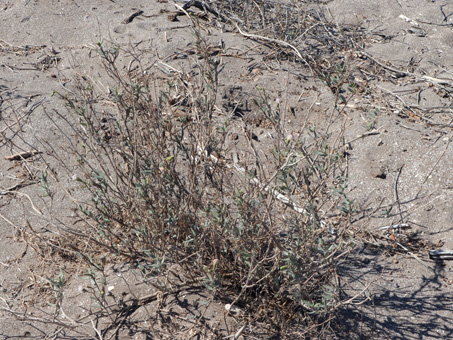
A spindly Spanish Needle (Palafoxia linearis, Asteraceae).
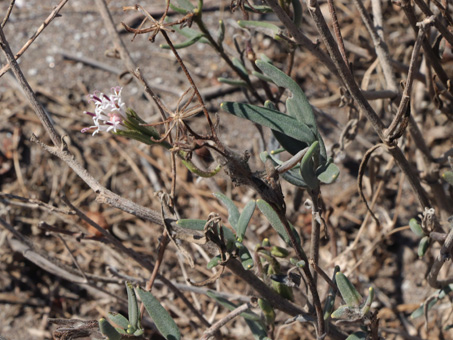
Surprisingly there were a few flowers on the Spanish Needle.
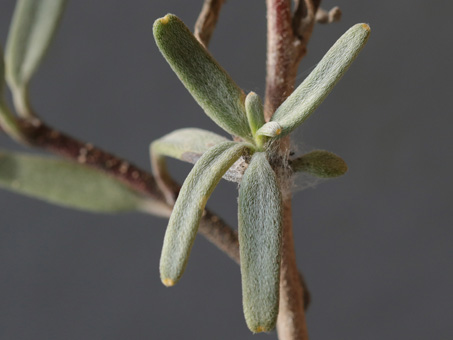
Closeup of the densely hairy leaves of Palafoxia linearis.
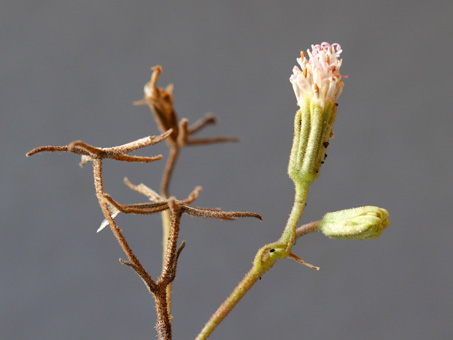
Closeup of the glandular stems and involucres of Palafoxia linearis.
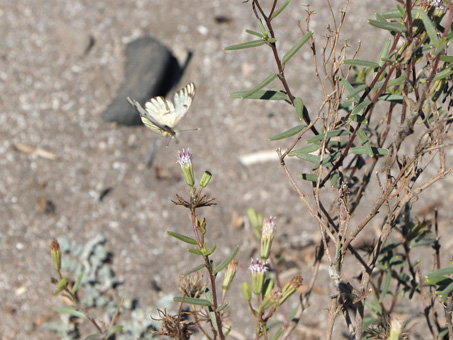
A Great Southern White butterfly (Ascia monuste subsp. raza) comes in for a landing on a Palafoxia flower.
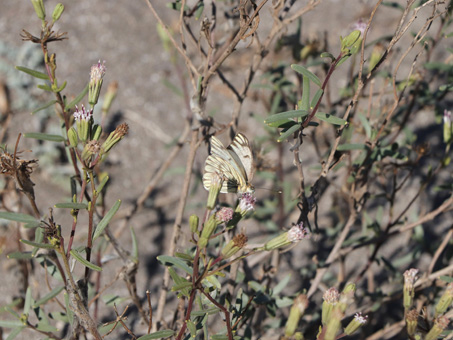
The Great Southern White butterfly now supping on the Palafoxia. I've seen this species many times in the last two years, mainly on the flowers of Lycium and Palafoxia along the beach or marsh.
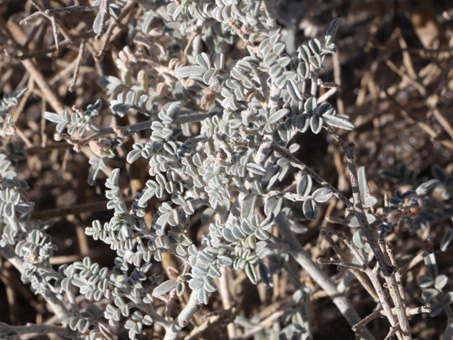
Dye Bush (Psorothamnus emoryi var. emoryi, Fabaceae). These leaves are drought-stressed and super hairy. No sign of flowers typical for this time of the year.
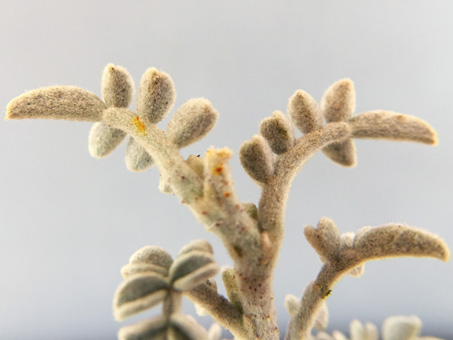
Closeups of the Dye Bush leaves showing the dense covering of hair and the few oil glands on the surface of the plant.
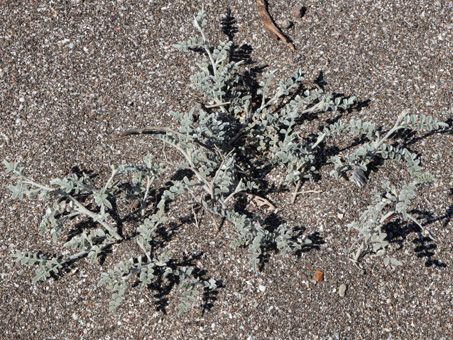
A less stressed specimen of Dye bush. The leaves are larger, flatter, and greener.
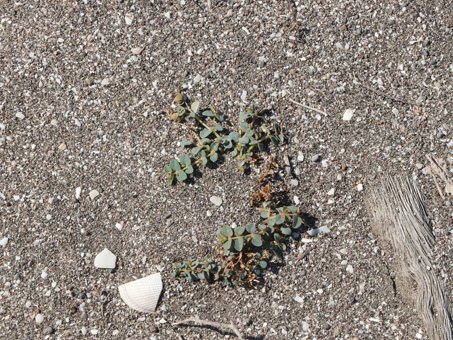
The first Small-seed sandmat (Euphorbia polycarpa) that I'd seen that was alive.
Around Mulegé — Punta Prieta Revisited
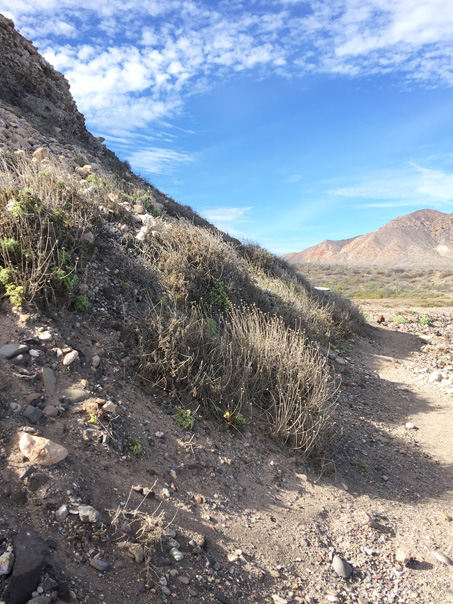
The perennial Coast Hofmeisteria (Hofmeisteria fasciculata, Asteraceae) at the base of the bluff. Talk about dry...
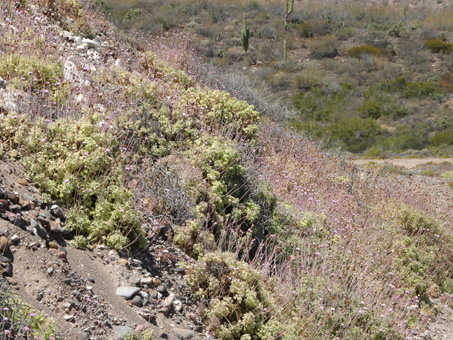
...as compared with these images from the same site in May 2020.
We´ve reached the end of the entry for this month. In the meantime, I'll be out into the field looking for some interesting finds. So until then, hasta pronto...
Debra Valov—Curatorial Volunteer
References
Rebman, J. P., J. Gibson, and K. Rich, 2016. Annotated checklist of the vascular plants of Baja California, Mexico. Proceedings of the San Diego Society of Natural History, No. 45, 15 November 2016. San Diego Natural History Museum, San Diego, CA. Full text available online.
Rebman, J. P and Roberts, N. C. (2012). Baja California Plant Field Guide. San Diego, CA: Sunbelt Publications. Descriptions and distribution.
Valov, D. (2020). An Annotated Checklist of the Vascular Plants of Mulegé, Baja California, Mexico. Madroño 67(3), 115-160, (23 December 2020). https://doi.org/10.3120/0024-9637-67.3.115
Wiggins, I. L. (1980). The Flora of Baja California. Stanford University Press. Keys and descriptions.



























































